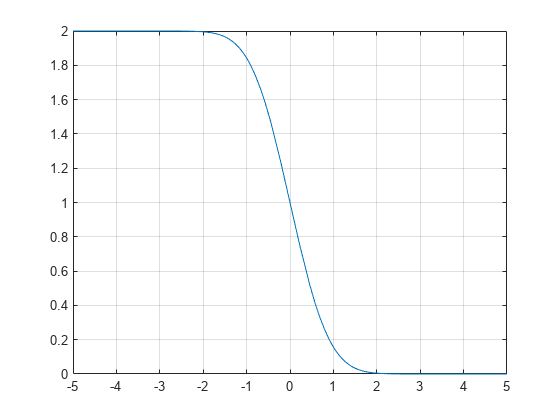erfc
Complementary error function
Description
erfc( represents the complementary error
function of X)X, that is,erfc(X) = 1 -
erf(X).
erfc(
represents the iterated integral of the
complementary error function of K,X)X, that is,
erfc(K, X) = int(erfc(K - 1, y), y, X, inf).
Examples
Complementary Error Function for Floating-Point and Symbolic Numbers
Depending on its arguments, erfc can
return floating-point or exact symbolic results.
Compute the complementary error function for these numbers. Because these numbers are not symbolic objects, you get the floating-point results:
A = [erfc(1/2), erfc(1.41), erfc(sqrt(2))]
A =
0.4795 0.0461 0.0455Compute the complementary error function for the same numbers converted to
symbolic objects. For most symbolic (exact) numbers, erfc
returns unresolved symbolic calls:
symA = [erfc(sym(1/2)), erfc(sym(1.41)), erfc(sqrt(sym(2)))]
symA = [ erfc(1/2), erfc(141/100), erfc(2^(1/2))]
Use vpa to approximate symbolic results with the required
number of digits:
d = digits(10); vpa(symA) digits(d)
ans = [ 0.4795001222, 0.04614756064, 0.0455002639]
Error Function for Variables and Expressions
For most symbolic variables and expressions,
erfc returns unresolved symbolic calls.
Compute the complementary error function for x and
sin(x) + x*exp(x):
syms x f = sin(x) + x*exp(x); erfc(x) erfc(f)
ans = erfc(x) ans = erfc(sin(x) + x*exp(x))
Complementary Error Function for Vectors and Matrices
If the input argument is a vector or a matrix,
erfc returns the complementary error function for each
element of that vector or matrix.
Compute the complementary error function for elements of matrix
M and vector V:
M = sym([0 inf; 1/3 -inf]); V = sym([1; -i*inf]); erfc(M) erfc(V)
ans =
[ 1, 0]
[ erfc(1/3), 2]
ans =
erfc(1)
1 + Inf*1iCompute the iterated integral of the complementary error function for the elements
of V and M, and the integer
-1:
erfc(-1, M) erfc(-1, V)
ans =
[ 2/pi^(1/2), 0]
[ (2*exp(-1/9))/pi^(1/2), 0]
ans =
(2*exp(-1))/pi^(1/2)
InfSpecial Values of Complementary Error Function
erfc returns special values for
particular parameters.
Compute the complementary error function for x = 0, x = ∞, and x = –∞. The complementary error function has special values for these parameters:
[erfc(0), erfc(Inf), erfc(-Inf)]
ans =
1 0 2Compute the complementary error function for complex infinities. Use
sym to convert complex infinities to symbolic
objects:
[erfc(sym(i*Inf)), erfc(sym(-i*Inf))]
ans = [ 1 - Inf*1i, 1 + Inf*1i]
Handling Expressions That Contain Complementary Error Function
Many functions, such as diff and
int, can handle expressions containing
erfc.
Compute the first and second derivatives of the complementary error function:
syms x diff(erfc(x), x) diff(erfc(x), x, 2)
ans = -(2*exp(-x^2))/pi^(1/2) ans = (4*x*exp(-x^2))/pi^(1/2)
Compute the integrals of these expressions:
syms x int(erfc(-1, x), x)
ans = erf(x)
int(erfc(x), x)
ans = x*erfc(x) - exp(-x^2)/pi^(1/2)
int(erfc(2, x), x)
ans = (x^3*erfc(x))/6 - exp(-x^2)/(6*pi^(1/2)) +... (x*erfc(x))/4 - (x^2*exp(-x^2))/(6*pi^(1/2))
Plot Complementary Error Function
Plot the complementary error function on the interval from -5 to 5.
syms x fplot(erfc(x),[-5 5]) grid on

Input Arguments
More About
Tips
Calling
erfcfor a number that is not a symbolic object invokes the MATLAB®erfcfunction. This function accepts real arguments only. If you want to compute the complementary error function for a complex number, usesymto convert that number to a symbolic object, and then callerfcfor that symbolic object.For most symbolic (exact) numbers,
erfcreturns unresolved symbolic calls. You can approximate such results with floating-point numbers usingvpa.At least one input argument must be a scalar or both arguments must be vectors or matrices of the same size. If one input argument is a scalar and the other one is a vector or a matrix, then
erfcexpands the scalar into a vector or matrix of the same size as the other argument with all elements equal to that scalar.
Algorithms
The toolbox can simplify expressions that contain error functions and their inverses.
For real values x, the toolbox applies these simplification
rules:
erfinv(erf(x)) = erfinv(1 - erfc(x)) = erfcinv(1 - erf(x)) = erfcinv(erfc(x)) = xerfinv(-erf(x)) = erfinv(erfc(x) - 1) = erfcinv(1 + erf(x)) = erfcinv(2 - erfc(x)) = -x
For any value x, the system applies these simplification
rules:
erfcinv(x) = erfinv(1 - x)erfinv(-x) = -erfinv(x)erfcinv(2 - x) = -erfcinv(x)erf(erfinv(x)) = erfc(erfcinv(x)) = xerf(erfcinv(x)) = erfc(erfinv(x)) = 1 - x
References
[1] Gautschi, W. “Error Function and Fresnel Integrals.” Handbook of Mathematical Functions with Formulas, Graphs, and Mathematical Tables. (M. Abramowitz and I. A. Stegun, eds.). New York: Dover, 1972.
Version History
Introduced in R2011b